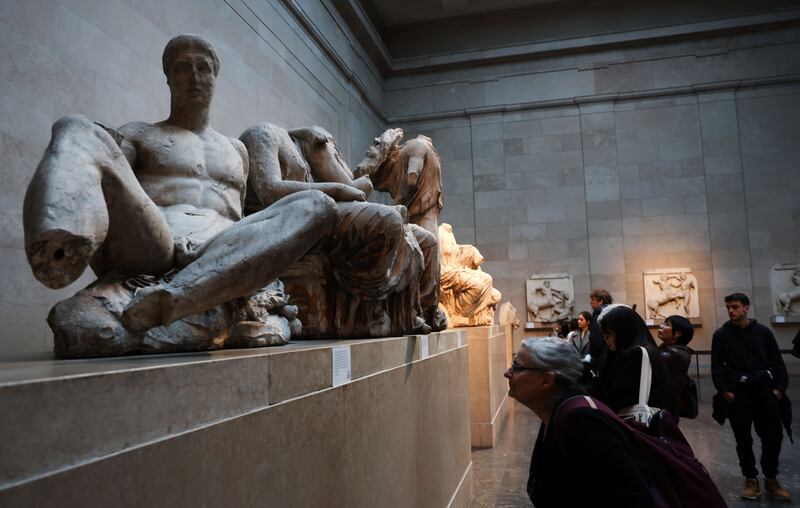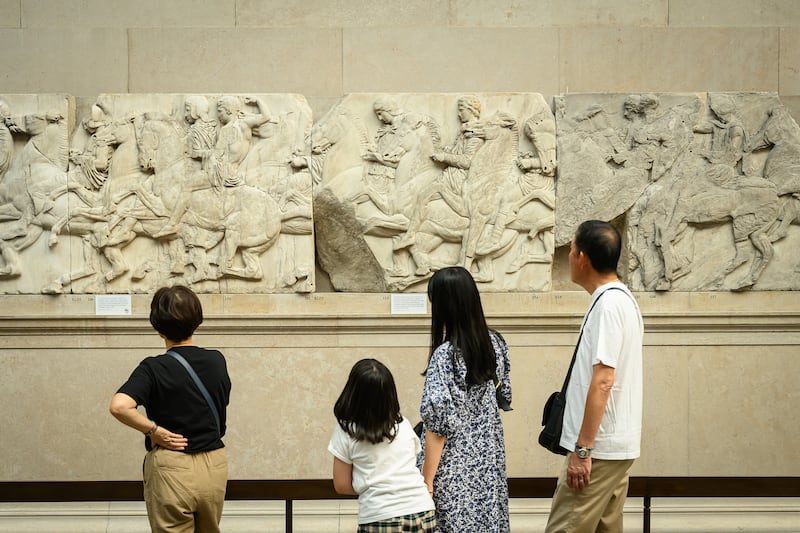This week’s spat between British prime minister Rishi Sunak and his Greek counterpart Kyriakos Mitsotakis about the Parthenon Marbles may have been a storm in a teacup, but the size of the teacup makes it one of the biggest messes of the year. Sunak, like his predecessors Boris Johnson and David Cameron, insists that the marbles belong to Britain. But his reason for cancelling his scheduled meeting with Mitsotakis in London on Monday makes him look very, very foolish. His statement is not merely crass, but illogical.
Downing Street insists that it was agreed there should be no mention of the marbles during the meeting, which was intended to prioritise migration and the situations ongoing in Ukraine and Gaza. The Greek government denies any such agreement. Mitsotakis had earlier met leader of the opposition Keir Starmer, who indicated he is generally positive to the return of the marbles. It seems that Sunak reacted to this and cancelled the meeting – an action which appears both intemperate and downright rude, and which EU vice-president Margaritis Schinas called “un-British”. It has been suggested in the Greek press that the cancellation was more to do with Britain’s relations with Turkey, with which a deal is about to be concluded on the sale of jet fighters.
Sunak told parliament it was unacceptable for the Greeks to “grandstand and relitigate issues of the past”, which his spokesperson referred to “long-settled matters”. One can readily appreciate the reaction of Starmer, who said “it’s the prime minister who has obviously lost his marbles”. Relitigate? Since there has been no litigation, it’s difficult to know what Sunak meant by this strange word. There is no court in the world that could adjudicate on this matter, since Greece was not in existence as a state at the time the marbles were taken from Athens in the early 19th century (when Athens was under Turkish control), and therefore was not a party to the original agreement – if agreement there ever was.
And “long-settled matters”? This, too, is meaningless, since for 40 years, since the Greek government formally raised the matter, it has been a major issue of contention which is far from being settled. Quite the opposite – as Sunak’s own reaction demonstrates.
How did the Parthenon sculptures ever reach the British Museum? Lord Elgin was the British ambassador from 1798 to 1803 to the Ottoman Empire, which at that time controlled much of southeastern Europe, including almost all of the Greek lands which today constitute the state of Greece (which did not come into existence until 1830, after a 10-year war of independence against Turkey). Elgin negotiated with the Turkish administration of Athens a document (over the status of which there was at the time, and remains, some dispute) allowing him to remove sculptures from the Parthenon temple.
Approximately half the frieze and pediments of the Parthenon were removed under this flimsy agreement, and were transported to London between 1801 and 1812, despite objections from philhellenes such as Lord Byron, who deplored their removal, writing of “walls defaced… by British hands”. Pressed for cash, Elgin sold them to the British government for the equivalent today of €5.5 million. They went on display in the British Museum in 1832, and generations of Britons have known them as the “Elgin Marbles”.

Recent diplomatic and cultural manoeuvres have persuaded public opinion to regard them as the “Parthenon Marbles”, reflecting their origin in the 2,500-year old temple on Athens’s Acropolis where, it is argued, they should be restored.
[ After 220 years, the fate of the Parthenon marbles rests in secret talksOpens in new window ]
George Osborne, chair of the British Museum (a former chancellor of the exchequer and regular visitor to Greece) has been working on a “long-term partnership” arrangement which would see the marbles being loaned to Greece in return for similar items from Greek museums. But the sticking point has always been ownership: Greece will not accept a “loan” of what it regards as its rightful property and heritage.
Like Osborne, Mitsotakis has tried to play down the question of ownership in favour of “reunification”, arguing that the separation of the sculptures is like cutting the Mona Lisa in half and having one half in the British Museum and the other in the Louvre. What is necessary, pragmatically, is for both sides to agree to disagree about ownership, in favour of a return of the sculptures to their home, whatever the conditions.

Recent decades have seen the question of ownership and appropriation raised internationally. The British Museum, like many major custodians such as the Metropolitan in New York and the Louvre in Paris, is sensitive to this threat to its trophies. Egypt, for example, has requested the return of the Rosetta Stone – the key to deciphering Egyptian hieroglyphics, which was taken by the French after their conquest of Egypt, and then appropriated by the British. In 2005 the British Museum gave Egypt a fibreglass replica of the stone – a gesture which many consider to have been the reverse of fairness and commonsense.
As a schoolboy I was able to actually touch the priceless Hermes of Praxiteles in what was little more than a shed in Olympia in Greece
In 2009, NUI Galway returned to a Canadian First Nations community the earliest known birchbark canoe. Small potatoes compared with the Parthenon marbles, perhaps, but it is consonant with the moral argument that items illegally or inappropriately acquired should be returned. Earlier this year, Pope Francis announced the return of three small pieces of the Parthenon to Greece. The gesture was more significant than the size of the donation.
As Finn McRedmond argued here in January, there is both an aesthetic and a moral argument for reuniting the sculptures, and public opinion both in the UK and internationally is coming to regard these arguments as superior to that of legal ownership.
For many years it was argued that the sculptures could be best preserved, and displayed, in London. This was certainly true in the earlier 20th century. As a schoolboy I was able to actually touch the priceless Hermes of Praxiteles in what was little more than a shed in Olympia in Greece. All that has changed. Where the old Acropolis exhibit was unfit for purpose, the magnificent new Acropolis Museum completed in 2009 is, aesthetically, far superior as an exhibition space to the British Museum. In a brilliant stroke of PR strategy, it has an empty gallery, waiting for the return of the Parthenon Marbles.
[ Acropolis row: Greeks outraged at concrete changes to ancient siteOpens in new window ]
There is, however, one obvious solution which gets around the issue of ownership: for more than 50 years the British Museum has produced perfect reproductions of Greek items in its collection, a skill which the Greek Antiquities department has also perfected. Copies, available to any collection which wanted them, could be made of all the sculptures and the originals placed in the Acropolis Museum – where tourists and Greeks alike could appreciate their beauty and colossal significance.
- Find The Irish Times on WhatsApp and stay up to date














